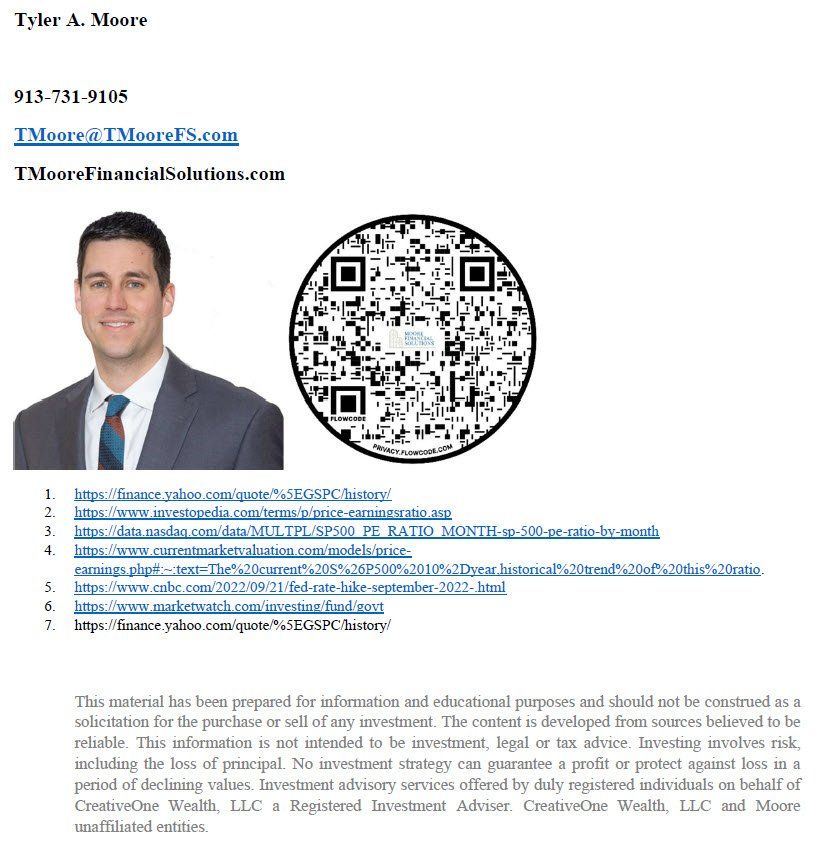October 1, 2024
With an election looming and the market going through what has historically been a bearish period for stocks, all eyes are on the Federal Reserve regarding their interest rate policy. The third quarter of 2024 offered positive returns for the S&P 500 of 5.53% (not including dividends) to close the quarter at 5,762.48 (1). The real narrative of Q3 is the emergence of bonds finally complementing stocks and producing a positive return, as illustrated by the iShares 20+ Year Treasury Bond ETF (ticker TLT) being up 6.89% (without dividends) (2). We’ll discuss our active management as well as more thoroughly discuss our fixed income strategy. Additionally, we plan to highlight allocation strategies regarding various asset classes as the Federal Reserve goes through their interest rate decrease cycle, and of course we’ll discuss potential impacts from the election. In our last quarterly review we offered, “We currently expect that rate cut to occur during the fourth quarter of this year, or slightly sooner.” This was far from a bold prediction as most of Wall Street agreed on this timing. Nonetheless, September 18th, 2024, was a huge day for the markets and Moore F.S. as the Federal Reserve reduced rates by .5% (3). However, the rate cut of .5% was slightly higher than the typical .25% cut, leaving some wondering if this was a sign the Federal Reserve should have reduced rates sooner and more gradually. As a reminder, the Federal Reserve had to aggressively increase rates to stomp down inflation that had arisen very quickly, and this rate decrease was a means to normalize rates in response to normalizing inflation data. In the opinion of Moore F.S., the bond market was not only pricing in this normal rate reduction, but additionally pricing in a recession, an event that would even more significantly decrease interest rates. In other words, as time went on without a rate decrease, some feared this meant a “hard landing” was in store for the economy because not only did Jerome Powell drive down inflation, but he potentially drove down growth by leaving rates too high for too long. Moore F.S. stayed true to our belief, and continued to voice a high likelihood of a “soft landing” in which the Federal Reserve’s timing of rate reduction is just right, or at least close enough. In this Goldilocks situation that we forecasted; Americans were earning interest income at a much greater rate given the sudden increase in rates which increases their discretionary spending. In addition, the labor market remained strong, thus keeping the economy very strong and resilient in the face of higher rates. On September 18th, 2024, Jerome Powell stated, “Our economy is strong overall and has made significant progress toward our goals over the past two years. The labor market has cooled from its formerly overheated state. Inflation has eased substantially from a peak of 7 percent to an estimated 2.2 percent as of August. We’re committed to maintaining our economy’s strength by supporting maximum employment and returning inflation to our 2 percent goal. Today, the Federal Open Market Committee decided to reduce the degree of policy restraint by lowering our policy interest rate by ½ percentage point. This decision reflects our growing confidence that with an appropriate recalibration of our policy stance, strength in the labor market can be maintained in a context of moderate growth and inflation moving sustainably down to 2 percent.” (4) We interpret this information to be straightforward and we give the Federal Reserve credit for the transparency it has given regarding policy change. In our opinion the bond market was pricing in a mild recession while the Chairman of the Federal Reserve was giving the message of confidence within the United States economy, it became the opinion of Moore F.S. that appropriate allocation changes needed to be made within our fixed income assets. On September 19th, 2024, we began the process of decreasing duration within our fixed income assets by selling our nearly million dollar position of iShares 20+ Year Treasury Bond ETF (ticker TLT) and received an approximate price of $98.95 per share. TLT closed the quarter at $98.10 (5). This longer duration debt ETF was generally replaced with the Blackrock Short Duration Bond ETF (ticker NEAR). This decision was reached for two primary reasons. First, we believe that TLT has moved rapidly higher on fears of a recession, not simply the Federal Reserve’s policy change. As rates ease back up as we envision, we believe that shorter duration debt will outperform. In other words, the bond market has gotten a bit ahead of the Federal Reserve. Secondly, TLT offered a yield of about 3.4% compared to the more attractive yield of about 5.14% in NEAR. We aimed to be heavily in long duration debt while interest rates decreased, and now aim to shift into shorter duration holdings. Not all clients hold fixed income funds. Though Moore F.S. tries to stay away from interest rate prognostications, we believe the yield curve will move entirely out of the inverted stage in 2025 as the Federal Reserve moves the Fed Funds rate back to a more normal level. Currently, the curve is still inverted in some areas. We believe banks will be a significant beneficiary of the normalization in interest rates as their lending operations become more profitable. When the yield curve is inverted, profit margins tend to fall for companies that borrow cash at short-term rates and lend at long-term rates, such as community banks (6). In other words, your bank was probably not as excited as you were to see moderate term certificates of deposit paying 4.00% and mortgages written at 6.5% than they would be to see rates on their deposits earning .5% and mortgages written at 5.00%. Simply put, banks care about the spread in interest rates not one given rate. In response to a normalizing yield curve, and potential steepening of the curve, Moore F.S. clients sold broad market ETF’s and purchased Goldman Sachs (ticker GS) within the third quarter. This, like the conversation regarding TLT previously, only applied to some accounts where we viewed this action as appropriate. In addition to the interest margins improving for Goldman Sachs, we see this adjustment as an advantage to investors for two reasons. First, Goldman Sachs offers a better P/E ratio than the broad market at approximately 16. For more information on P/E ratios please see our First Quarter ’24 review in paragraph two where we discuss how P/E ratios influence our management approach. Secondly, Moore F.S. is always attempting to keep expense ratios lower by using single stocks in small weightings when appropriate. We hope this exemplifies the firm working hard to keep your expenses under control, while many other firms might simply use pre-built models, passing that higher cost on to you. We feel it is important to mention that Moore F.S. will never attempt to time markets, but rather react to public information and manage each account individually to the best of our ability. Below charts the spread between two and ten year U.S. treasury obligations, which is generally the spread analyzed The yield curve on September 30th, 2024, showing short term debt obligations paying a higher yield than long term obligations by most technicians. Historically investors have been rewarded with a higher yield for risking their money for a longer duration, but not always. Keep in mind, ultra short rates, such as the three-month treasury obligation offer 4.73% (7), and moderate term rates, such as the ten-year treasury obligation offer 3.81%, as of the last day of the quarter (8). We feel this temporary inversion is holding banks like Goldman Sachs back from their full potential. From the perspective of the stock market and global economy operating smoothly, we view the best election outcome as one with a clear winner, with conventional wisdom offering that a result that drags on for days is bad for markets. With two candidates offering quite contrasting plans and visions, we see corporations as most likely in a holding pattern, waiting for more clarity in variables such as corporate tax rates or manufacturing location incentives. We imagine these are the same corporations that have been in a holding pattern waiting for more clarity on the path of interest rates for the last couple of years. We feel that corporations benefit from stability and clarity, and when those are low, our best chance to manage portfolios appropriately is to not take a side, but rather, feel that our portfolios can benefit from either candidate winning. Once the election is passed, we will plan to craft portfolios in the fourth quarter in preparation for 2025 based on our view of the path of leadership. With another quarter passing by, I want to take a moment to thank you for your continued trust in me as your advisor and remind you that your financial goals are my professional goals. As I continually say, investing on any scale tends to be an emotional experience and I very much try to cushion that emotion for a client, if possible, without becoming too conservative. In other words, I must walk a fine line between selecting assets that blend well to potentially bring correlation or risk down in a portfolio, without including such conservative assets that reduce our chances of hitting your long-term goals. This will be my fourth U.S. presidential election while entrusted to manage assets, and my focus tends to be twofold; not try to predict a winner in my style of investing and to get clients through it. One key take away I have from listening over the years is how people have managed their own money through elections. Though I don’t have solid research or data to back it up, it is my experience that do-it yourself investors often make far too drastic of allocation changes that are far too dependent on the outcome they have predicted. I highly encourage you to take just a moment to think of someone that could benefit from the no pressure advice and strategies that Moore F.S. offers. In today’s transient labor market, everyone knows someone that has transitioned jobs and has left behind 401(k) assets. Think to yourself how those assets might perform sitting there, compared to how they might succeed over long periods of time at Moore F.S. My hope is for you and your family to have another great holiday season and a great end to 2024 between now and my next review. As always, I’m personally just a phone call away if you need anything or have any questions. Tyler A. Moore




